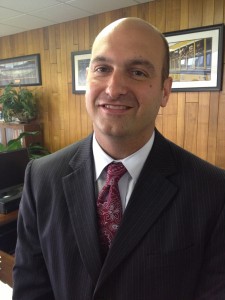Superintendent Nikolai Vitti On His First Year in Jacksonville, Race, And The Challenges To Florida Schools
Nikolai Vitti knows how dissimilar Florida’s school districts can be — but as the new Superintendent of Duval County Public Schools, he also recognizes common challenges.

Sammy Mack / StateImpact Florida
Nikolai Vitti has been superintendent of Duval County Public Schools since November 2012.
Vitti arrived in North Florida last November, leaving behind a job as chief academic officer for Miami-Dade County Public Schools.
On the surface, Miami-Dade and Duval represent two very different kinds of Florida school districts. There are nearly 350,000 public school students in Miami-Dade—close to two thirds of them are Hispanic, nearly a quarter are black. The Duval school system has about 125,000 students, 44% of whom are black and 39% of whom are white.
Vitti sat down with StateImpact Florida to talk about the transition from South Florida to North Florida—and what he learned during his first school year on the job.
Q: What are some of your surprises moving from Miami-Dade County to Duval County?
A: Folks here know that public education can be better. And they’re willing to put their shoulder to the wheel to make it better.
I do believe that maybe six years ago, seven years ago, Miami was in a very similar situation. It knew that it needed to change things around. It brought an outsider in with Rudy Crew. And he changed the infrastructure of the school district. Then Alberto Carvalho — who was in the district and played the role in allowing Rudy to be successful — built on the changes that Rudy made.
And so I saw the transformation process in Miami and I see us in Jacksonville very similarly in the sense that, just like in Miami, there’s a recognition that something was wrong or something could be better and it required a new leader to do that. But also in Miami there was a recognition that a leader by him or herself cannot do it alone, that a community has to rally behind the change.
I think obviously the difference here is that we don’t have the same high influx of immigrant students, not as many Hispanic students. Many of the challenges that I believe existed and still exist in Miami regarding the African-American community is very similar here. I think progress has been made here but much more work [is necessary] in that area regarding narrowing the achievement gap and raising the bar of expectations for all students regardless of zip code and race.
Those are issues that every district throughout the country faces.
Q: What do you think are the biggest challenges facing Duval County as opposed to a place like Miami-Dade County?
A: Overall, the general perception of public education was higher in Miami than it is in Jacksonville. And so although there are pockets of individuals in Miami that believe the public education system is faulty and needs improvement, I would say at scale there is a deep concern here in Jacksonville and a lack of trust throughout the entire city. People have lost faith in public education in Jacksonville.
I think that started way before I came… with things like failing the accreditation process, to issues of segregation and desegregation. Issues that plague Miami, but it has left a significant scar here. And years of FCAT letter grades have led to eroding of public confidence in Jacksonville.
But the hope here is that there’s a group of people that are highly involved, highly engaged, that are bringing resources to the table.
Q: You’ve proposed a lot of initiatives aimed at closing the achievement gap — a parent academy to engage families, expanded summer school, alternatives to out-of-school-suspensions, recruitment of more African-American male teachers. What will it take to actually do that?
A: It’s reinventing the strategic plan. We made our strategic plan much simpler. It’s actually on one page, not 50 pages. And it focuses on four main areas: 1) developing great leaders and teachers; 2) engaging parents, caregivers and the community; 3) being more efficient, effective, and equitable with our resources. And then the fourth area of focus is developing the whole child.
That’s something I didn’t talk about earlier, and that’s the other reason why I think we’re seeing the disparity. We’ve lost focus on music and arts in our schools — especially in our urban core where our students that happen to be below grade level are being pulled out of art programs in order to do remediation.
What’s happened in our schools is there’s such a focus on standardized testing, we’ve lost the fact that our schools should also be building better human beings, better people.
We’ve done zero-based budgeting. Which is asking the question for every division, every area in the budget: Why are we doing this? And how is it aligned to the strategic plan? It has shifted resources from the district level to schools to fund many of the programs and initiatives, and it’s made us certainly more efficient and streamlined.